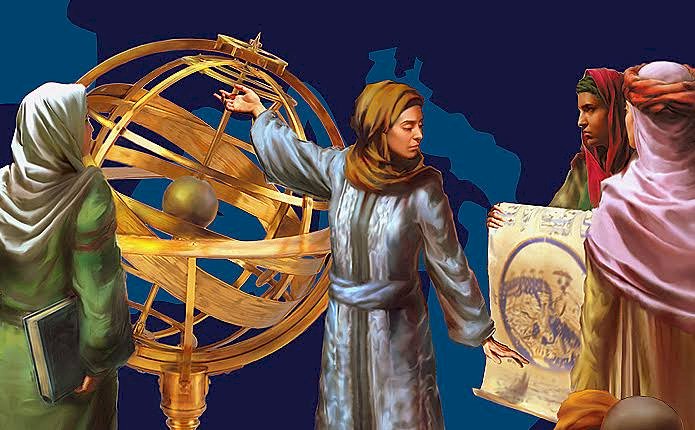Major Female Figures in Islamic Jurisprudence: The Medieval Period (Part Three)
INTRODUCTION
Women scholarship has contributed a great deal to the gradual progress of Islamic jurisprudence. The long span between the third and tenth centuries is considered"medieval"as the period from the 10th century is denoted as "later". During the time, some women scholars conducted classes while few others dealt with Fiqh and related studies. It was also a time when many scholastic families thrived in Egypt and Syria and produced a lot of women jurists like the family of ʿAsqalāni, Bāʿūni and ibn Aslam. Now, let us look at some female jurists who lived in the medieval period from four schools of Islamic jurisprudence.
ḤANAFI SCHOOL
Khadīja bint Muḥammad Juzjāni Ḥanafi
Khadīja, daughter of Muḥammad bin Aḥmad Abu Raja al-Qāḍi al-Juzjāni, studied Fiqh and Hadith from her father[1].Ḥākim says in his work "History of Naysābūr" that she lived more than 100 years and was well-versed in Arabic literature and writing. She passed away in 372 AH.
Fāṭimah bint Muḥammad bin Aḥmad al-Samarqandī
Fāṭimah al-Samarqandī (died in 578 AH) was one of the great jurisprudential figures from Aleppo and a scholar of many disciplines in the Arab world. She had a deep relation with then Caliphs like MālikʿĀdil al-Ayyūbi. Fāṭima used these bonds meaningfully for the dissemination of knowledge among people. She learned from many well-known scholars, including her father,Imām Alaʾuddīn Muḥammad bin Abī Aḥmad al-Samarqnadī. Additionally, she memorized her father's masterpiece'Tuḥfa' started issuing fatwā along with her father.[2]
Fāṭimah al-Ḥanafiyyah got many marriage proposals from various rulers, including Rome's kings, due to her elegance and scholarly brilliance. However, all proposals were rejected, and Imām Alaʾuddīn chose his pupil and Amīr of Kāsan,Alaʾuddīn as her life partner. Kāsāni wrote a commentary titled 'Badā‘i al-Ṣanā’i 'fi Tartib al-Sharā’i' for his father in law's work and the jurists of that time began to say,"He (Kāsāni) explained his (father in law) work and married his daughter". After her marriage with Kāsāni, both headed towards Aleppo and Kāsāni was appointed as the main teacher of Madrasa Ḥalabiyyah by Nūrudīn Muḥammad bin Zanghī. Fāṭimah engaged in writing texts in jurisprudence and Ḥadīth and became an exponent of Ḥanafi School in Aleppo. She stayed there till death and was buried inside the dome of Maqam Ibrāhīm.
Khadījah bint Muḥammad al-Ḥanafi[3]
Khadījah was the daughter of Muḥammad, son of Ḥasan al-Bābi from Aleppo, who was a well-known figure in the al-Baylūni tribe.She was pious and famous in Islamic jurisprudence of Ḥanafi School[4]. She was permitted to report Ḥadīth from Ṣaḥīḥ al-Bukhāri by the great scholar Ibn al-Nāsikh al-Ṭarāblīzi. She learned and followed Ḥanafi School,though her father and brother were Shafiites.Khadīja al-Baylūni spent her whole life in religious affairs till her death in 930 AH.
Khadījah was the daughter of Muḥammad, son of Ibrāhīm al-Muqri al-ʿĀmirī, the Ḥanafite and was devout, popular, and knowledgeable in juridical knowledge.Acquired knowledge from many scholars like Imam Raẓiyudīn, the author of book al-KawākibuSāʾira, she reported Ḥadīth from her father in Ṣaḥīḥ al- Bukhāri and narrated some knowledge related to Fiqh. Her death was in Rajab of 935 AH.
Fāṭimah bint Qāḍi Kamaludīn bin Maḥmūd bin Sīrīn (Suṭayṭa)[5]
Born in Cairo in 855 AH, she learned and specialized in Islamic legal studies from the same city. Fāṭimah was married to Nāṣir Muḥammad bin Tahanṭaba, and after his demise, she got married to Baybar. Being well-versed in literature with a thorough understanding of revealed knowledge, she wrote many literary works for many linguistic experts and Qāḍi of Makah in particular. Fāṭimah was very pious and devout and performed Ḥajj many times. Her demise was in 941 AH.
Fāṭimah bint Abdul Qāḍir bint Qarīmzān al-Ḥanafi
Fāṭimah, who was born in Muḥarram 897 AH as the daughter of Abdul Qāḍir bin Muḥammad bin ʿUthmān, was known as the "Daughter of Qarīmzān".[6]She was religious and a reputed scholar of Ḥanafi School that hails from Aleppo. Her writing skill was incredible, and she wrote many works based on Fiqh and edited numerous books. She was kind-hearted and kept strict punctuality in prayers even while sick.[7]
She was married to the famous Shāfiʿī scholar Samāluddīn ʿAlī Darvesh al-Irdabli who was the coordinator of Madrasah al-Rāḥavayya in Aleppo[8].She used to say,"Almighty Allāḥ gifted me 36 odd pieces of knowledge". She asked her family to bury her prayer mat along with her body and died in 966 AH.
Click here for the first part: major female figures in islamic jurisprudence Ṣaḥabiyyat
Tāhirah bint Aḥmad al- Tanūkiyyah[9]
She is Tāhira bint Aḥmad bin Yusuf al-Arzaq al-Tanūkiyyah. She hailed from a scholastic family and was a connoisseur in Fiqh, Ḥadīth and other Islamic disciplines.[10]She studied Fiqh and reported Ḥadīth from her father, and also received Ḥadīth from Abu Muḥammad bin Maʿsi, Mukhallad bin Ja'feral-Baqarhi, Abul Ḥasan bin 'Lu'lu’, Abū Bakar bin Ismaʿīl al-Warrāq, and Abul Ḥasan al-Bawwāb.
MĀLIKI SCHOOL
Asma bint Asad bin Furāt[11]
Asma bint Asad bin Furāt al-Qairuvanniyyah was the daughter of a famous African scholar, Asad bin Furāt.Having lived and grown in a condition filled with studious vibes of knowledge and wisdom, she attended educational classes and debates held ather own home and became famous for her moral character and an expert in Ḥadīth and Fiqh.
When her father Asad took over the headship of the military, he determined to seize Sicily island in the region of Yazīd. Allāḥ the Almighty granted an overwhelming victory to Qāḍi Asad.He was martyred in 213 AH while besieging Zaragoza, the capital cityof Zaragoza province and the autonomous community of Aragon, Spain. After her father's death, she was married to one of her father'sdisciples, Muḥammad bin Abil Jawād who succeeded his teacher as Qāḍi and Sheikh of Ḥanafi of his region in Africa. At the same time, he had faced tribulation from the caliph and was imprisoned.After a long struggle, he was set free and regained his lost glory and fame. Asma al-Asadiyya continued her service for Islam and knowledge till her death in 250 AH.
Khadījah bint Saḥnūn (Māliki)[12]
Khadījah was the daughter of al Imām Saḥnūn bin Saeed al-Tanūkhi, an influential scholar of Māliki School in Morocco.Qāḍī mentions in "TartībulMadārik"that Khadījah was wise, scholastic, confident and mastered all Islamic disciplines. Her father used to seek fatwā from her on several issues. When he was nominated to the position of judge, he accepted it only after hearing his daughter's opinion. Her brother also did the same after the death of Imam Saḥnūn. She studied Hebrew from her father. The women of her era used to come to her asking fatwā on female-related affairs.
Abu Dāwūd al ʿAṭār said: "Abu Ja'far Aḥmad bin Lubda, son of Saḥnūn's brother, sent me to propose Khadīja for him in front of Saḥnūn, but he did not say anything. The proposal continued even after the death of Saḥnūn and his son, to which she always refused. She spent her whole life worshipping Allāḥ and issuing fatwā. She remained unmarried and died in 270AH.
Khadījah bintʿAli[13]
She was the daughter of Ibnul Mulqan and mother of Ummu NūrʿAlī bin BahaʾAḥmad bin Uthmān. She was one of the great faqīhath among her colleagues and an expert in Ḥadīth. Imam Sakhāwi says: In her childhood, she trained reading Quran and related knowledge, writing techniques and religious affairs. She issued fatwā on menses.
Khadījah's primary education was under the supervision of her scholar father Ibnul Mulqan and brother ʿAbd al-Raḥmān. Her father was a memorizer of the Quran and succeeded in reporting Ḥadīth with his undeniable capability to handle revealed knowledge. At the same time, ʿAbd al-Raḥmān was skilled in reading classical texts and learned Quran and other scriptures by heart. Her son was also well-versed in Arabic grammar, including Alfiyah ibn Mālik, syntax and Quran.
This educated lady from a distinguished scholastic family became skilled in Ḥadīth, and learned Muwaṭa bin Mālik from ʿIzz bin Abul Yaman as per the narration of Yaḥyā binYaḥyā from Mālik. Many scholars, including Imam Sakhāwi, heard Ḥadīth from Khadījah. She was born in 788 and expired in 873AH.
Reference
[1]ʿ Abdul Qādar bin Muḥammad al Qurashī, al JawāḧirulMāliyyafīṬabaqātilḤanafiyya,(Riyād:DārulʿUlūm 1395 H), P: 12O,
[2] Zaynab Ali Abdul Majid,LamʿulIshāratFīṬabaqāhiNisāʾ il Faqīḧāt,(Cairo:women and cultural studies, 2001),P:8
[3] Abdul Ḥayy bin Aḥmad bin Muḥammad al Makkī al Ḥanbali, ShadarathuDhaḧābfīAkhbārīn min Dhaḧāb,(Damascus:Dāruibnu kathīr,1403 H),P:172,V :8
[4]Najmudīn al Ghāzi ,al KawākibulSairat bi A’ayānilMiʾatilAshīrath,(Bierut:Dārulāfāq al Jadida,1399 H),P:196, V:192
[5]MuḥammadʿAli al Shaukāni, al Badrul Thali’ bi Maḥāsin min Ba’diQarniThasi’(N.P),P:12,V:2
[6]Abdul Ḥayy bin Aḥmad ,ShadaratuDhaḧāb, V:8, P: 347-348,
[7]MuḥammadkhayrRamaḍānYūsuf, FaqīḧātunʿĀlimātun, P: 12
[8] Ibid
[9]Abdul Qādir bin Abul Wafa’Muḥammad bin Abul Wafa al Qurashi, al JawāhirulMaliyyat fi Thabaqth al Ḥanafiyya,(Karachi:MirMuḥammadKuthubKhana,N,d),P:227,V:2
[10] Abu Abdulla Muḥammad bin Aḥmad al masnae al Anshi, MisbāḧulʿArīb fi ThaqrībAlladhīnaLaisu fi Taḥqīq al Taḥdīb(Cairo:Al Farooq al Hadīth al Thaba’tiwal Nashr,2009),P:335,V:4, ʿʿAmrRiḍāKaḥāla, A’lam al Nisa’ fīʿĀlami al ʿArabiwal Islam,(Beirut:Muassat al Risala,N.d),P:364,V:2
[11] Ibid, V:1,P:22-23
[12]ḤasanḤusni Abdul waḧab,Shaḧīrath al tūnisiyyath,(Tunis:Maktabat ul Manarāt,1405H), V:1,P:47-48
[13]al Doʿu al Lamiʿ,V:29,P:12
(Sayyed Mashur Hudawi is a Lecturer at Quran Department, Straight Path International School)
Disclaimer
The views expressed in this article are the author’s own and do not necessarily mirror Islamonweb’s editorial stance.

























Leave A Comment